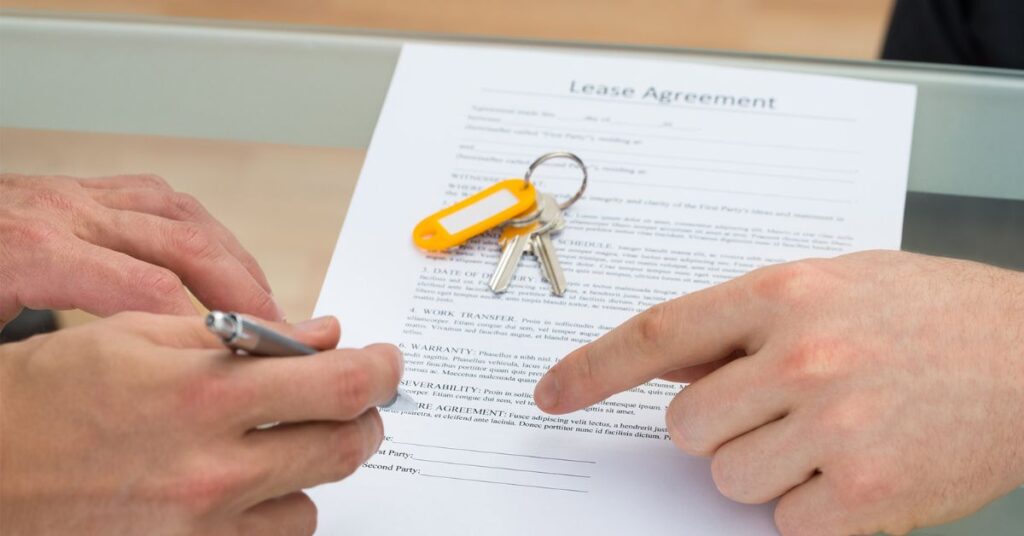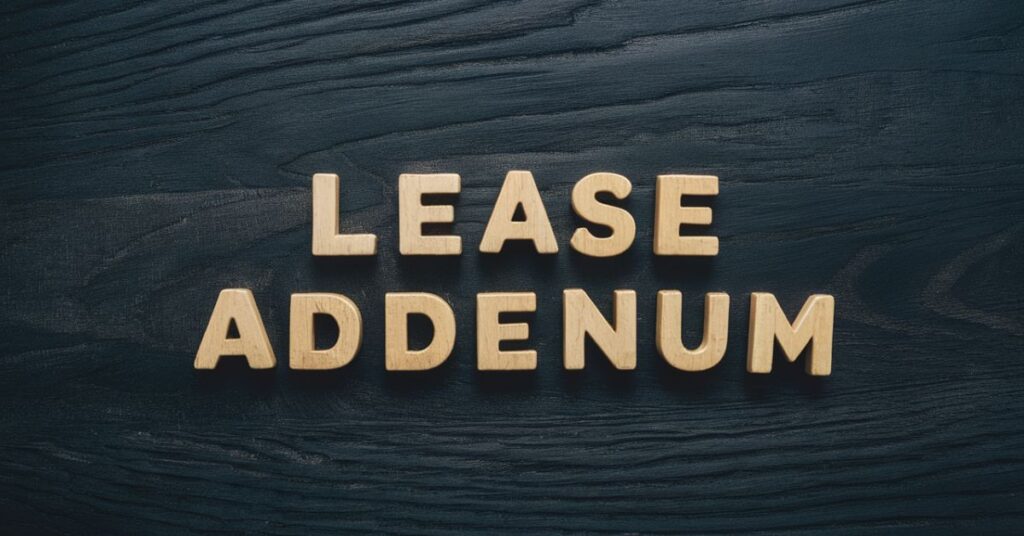A lease addendum is a separate document attached to a lease agreement, introducing new terms and conditions without altering the original lease. It’s essential for addressing specific issues like pet policies or maintenance rules that weren’t covered initially.
Curious about when and why to use a lease addendum? Stay with us to learn how these documents can protect both landlords and tenants, ensuring a smooth rental experience.
When to Use a Lease Addendum
Introduce New Rules or Policies
A lease addendum is the best way to bring in new rules or policies, which may not be addressed in the original lease. For instance, if a landlord wants to introduce a new pet policy or smoking restriction, the addendum avails the possibility of doing this without changing the basic terms of the lease. This ensures clarity in regard to the new conditions to both parties.
Outlining Property-Specific Features
Those properties with special facilities or features may require additional stipulations, and these may be addressed in an addendum. For example, a property containing a swimming pool, gym, or rooftop terrace could add stipulations into the addendum for usage, access, and maintenance. This helps further customize toward specific property needs.
Adding New Fees or Charges
A lease addendum does provide a legally clear manner in which such change could be communicated upon the introduction of new charges or fees, whether it be for parking or utility adjustments. This outlines when and how such charges apply, therefore averting potential miscommunications and disputes between landlords and tenants.
Temporary Changes
Addendum may be used to institute temporary changes, such as allowing quiet hours in honor of a special event or putting restrictions in place during a renovation process. This document will introduce temporary rules without tampering with the original lease, thereby providing clarity and reducing potential conflicts.
Accommodating Specific Requests from Tenants
Second, the lease addendum can be used in case some tenant has certain requests regarding a property, for example, the installation of some disability-related features. It clearly outlines all the accommodation being extended to the tenant with regards to terms and responsibility of both parties with corresponding costs, so that both parties are well-protected.
How to Draft a Legal Lease Addendum

To draft a legal lease addendum, there are a few primary steps that a person will want to take to ensure it is enforceable and crystal clear. Start with the basic information of all parties, lease dates, and the effective date of the addendum. Specify particularly any matter being addressed and use precise language that will not be ambiguous. Title it properly, have all parties sign it, and respect all local laws. By following these guidelines, one will be well on their way to developing a stout, legally sound lease addendum that supports a lease agreement.
Common Myths About Lease Addendums
Some of the common misconceptions about lease addendums can be understood in property management. People think that if the lease is all-inclusive, there is no need for addendums, or they apply only after the tenant has already taken up residence. Some think tenants do not have to sign an addendum if it was handed out with the lease. On the contrary, most of the time addendums are needed to explain some special terms and do require the acknowledgement of all parties for them to be legally effective. The following myths are now debunked to ensure correct usage and control of lease addendums within rental agreements.
Best Practices for Using Lease Addendums
- Clarity and Specificity: Ensuring the addendum is clear and specific to avoid misunderstandings.
- Consistency with Lease: Ensuring addendums do not conflict with the original terms.
- Regular Reviews: Periodically reviewing and updating addendums as necessary.
- Communication: Keeping open lines of communication between landlords and tenants about any changes.
Benefits of Professional Property Management
- Expertise: Leveraging the knowledge and experience of property managers.
- Compliance: Ensuring all documents comply with legal standards.
- Efficiency: Streamlining the process of drafting, implementing, and managing addendums.
- Peace of Mind: Providing landlords with peace of mind by handling daily operations and legal compliance.
You may also like to read about : Dnd Size Chart: A Game-Changer for Your Adventures
Best Practices for Lease Addendums
- Clarity and Specificity Responsibility: Be clear and specific, so there is no room for misunderstanding.
- Consistency about the lease: Consistent with the lease so as to avoid contradicting term statements.
- Regular Review: Review the addendums regularly, and revise them.
- Communication: Keep an open line of communication about the changes and the reasons
Benefits of Professional Management of Property
- Knowledge: Use property managers for their knowledge and experience.
- Compliance: Sign all the proper documentation under compliance standards.
- Efficiency: It simplifies the process of drafting, administering, and managing addendums.
- Peace of mind: It gives the landlords peace of mind, knowing that it deals with the day-to-day operations and legal compliance.
Lease addendums vs. lease clauses

Lease Clauses
Lease clauses are portions of the actual lease. They identify the central conditions of your rental agreement and are most often not open to negotiation. Clauses spell out critical facts, including:
- Parties Involved: All parties to the tenancy, including both the tenants and the landlord.
- Lease Term: Beginning and ending dates of the lease.
- Security Deposit: Conditions regarding the amount of money, the place where it will be stored, and under what conditions and when it will be returned
- Monthly Rent: The actual amount, form, and when the payment is due.
- Late Fees:Penalties and Grace Period for Late Rent
- Tenant Responsibilities : Regarding Property Maintenance and Conduct
- These form the basis agreement, but also serve to protect both parties’ interests by mandating compliance with local, state, and federal laws.
Lease Addendum
While aaddendum is utilized as a supplement or addition to the original , they are separate documents that modify . An addendum brings forth or puts forward new conditions and issues that were not in the original. Key points include :
- Purpose: Addendums are modified to accommodate specific situations or changes, for example, pet policies and smoking regulations or those regarding parking.
- Flexibility: Unlike fixed clauses in the lease, addendums allow for alteration and additions as needs may change or by mutual agreement.
- Legality: To make the addendum legally binding, it should first of all be agreed upon and signed by both landlord and tenant.
Knowing the difference between a clause and an addendum helps the parties ensure that all the terms of a rental agreement are well-stated, comprehensive, and legally binding.
Key elements of a lease addendum

A very important document in leasing transactions is the addendum, used to complement or change the terms within an already existing agreement. Some elements should feature in an addendum to make it effective and binding. Here is a breakdown of the same:
- Title and Introduction: The addendum should be clearly titled as to its purpose, such as “Pet Policy Addendum” or “Parking Space Addendum.” The introduction briefly explains why the addendum is being added to the lease.
- Reference to the Original Lease: Indicate the date of execution of the original and briefly describe its contents. This is for purposes of identification and also relating the addendum to the main lease.
- Contact Information: Full contact information for the landlord and the tenant(s). It allows easy follow-up or clarification in case something arises.
- Detailed Description of Updates: Clearly outline the new terms or provisions being introduced. Explanations concerning changes or additions to the agreement should be worded with simplicity and ease of understanding. Be specific to avoid any possible misunderstandings.
- Effective Date: Specify when the new terms will take effect. This could be immediate, at a set date in the future, or retroactively, depending on the nature of the changes.
- Signatures: Both parties have to sign and date the addendum to show their consent. This is very important because this makes the addendum legally binding.
- Notarization: Some jurisdictions may require notarization for a addendum. Check with local regulations to see if there is any requirement for notarization.
- Witnesses: There are instances when the signature by witnesses further justifies the legality and authenticity of the addendum. It depends on local laws and the nature of the agreement.
- Severability Clause: Put in a severability clause providing that the remaining will continue in force in case a part of the addendum is held to be unenforceable.
- Integration Clause: This clause indicates that the addendum is integral to the agreement and shall supersede any conflicting terms of the original lease. The new terms, thus, will have precedence.
Together, these elements go into the making of a addendum that is clear, comprehensive, and legally binding. It helps both landlords and tenants to know exactly their rental agreement as modified.
You may also like to read about : Can a Landlord Change the Lease After It Is Signed?
Generate lease agreements with Docusign
Getting agreements through DocuSign is efficient and secure. You can generate your documents in DocuSign from predefined templates, add specific details, and send them for an electronic signature. Once everyone has signed, DocuSign distributes the final copy and saves a signed version in your account for you, ensuring a smooth, uncluttered workflow. Aside from saving time, this digital approach drastically reduces paperwork and adds to the security of the documents.
Conclusion:
Addenda to a lease are important documents in the administration of a rental agreement; they lend flexibility to clarity in modifying or adding terms to an existing . Understanding the major elements and proper usage of addendums will help to ensure that both landlords and tenants have comprehensive and legally sound agreements. Whether it’s new policies, peculiarities of a property, or specific tenant requests, a well-written addendum greatly avoids confusion and sets a tone for a lucid rental relationship. Digital solutions, like DocuSign, provide a clear avenue to making things even easier regarding how one handles documents. Armed with these insights, you would have no doubt about the intricacies involved with agreements and addendums, and be on your way to an ultra-smooth and very effective rental experience.
People also ask
What is the purpose of an addendum?
An addendum modifies or adds specific terms to an existing agreement without altering the original contract.
What is an addendum example?
An example is a “Pet Policy Addendum” that outlines new rules for pets in a rental property.
What is the addendum to a contract clause?
The addendum to a contract clause introduces additional conditions or details that supplement the original clause.
What is the meaning of addendum in a deed?
In a deed, an addendum specifies additional conditions or changes to the property transaction or ownership terms.







